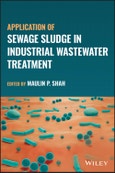Application of Sewage Sludge in Industrial Wastewater Treatment provides a roadmap to the methodologies for the treatment of industrial wastewaters from several major sectors integrating theory and practice, highlighting the importance of sewage sludge technologies in industrial wastewater treatment to clean up the environment from pollution caused by human activities, and assessing the applications of several existing activated sludge techniques and introduces new emerging technologies. All discussion within the text is based on a solid theoretical background.
Application of Sewage Sludge in Industrial Wastewater Treatment covers key topics such as: - Issues related to activated sludge treatment, such as biodegradability-based characterization, modelling, assessment of stoichiometric, and kinetic parameters and design - Issues related to industrial pollution control, such as in-plant control, effect of pretreatment, and more - Recently increasing quantity and complexity of toxic effluents, which can be bio remediable for plants and suitable microbes, whether natural or customized for specific purposes - Ecological, profitable, and natural solutions designed to eliminate heavy metals, radionuclides, xenobiotic compounds, organic waste, pesticides, and more
This reference provides an essential, one-of-a-kind, integrated approach for environmental microbiologists, biochemical engineers, environmental engineers, effluent treatment plant operators, and biologists and chemists at wastewater treatment plants.
Table of Contents
1 Sludge Conditioning, Activation, and Engineering 1
Joe Cyril Harrish A.M and Hitesh S. Pawar
1.1 Introduction 1
1.2 Conditioning 2
1.2.1 Conditioning of Sewage Sludge by Increasing the Rate of Hydrolysis 2
1.2.1.1 Mechanical Pretreatment 2
1.2.1.2 Thermal Hydrolysis 4
1.2.1.3 Chemical Pretreatment 4
1.2.2 Conditioning for Sludge Dewatering 6
1.2.2.1 Physical Conditioning 6
1.2.2.2 Chemical Conditioning 8
1.3 Activation of Sewage Sludge 10
1.3.1 Adsorbents Produced by Thermal Carbonization 11
1.3.2 Adsorbents by Physical Activation 12
1.3.3 Adsorbents after Chemical Activation 12
1.3.4 Surface Chemistry of the Sewage Sludge-Based Adsorbent 13
1.4 Conclusion 14
2 Emerging Issues and Their Solutions Related to the Use of Sewage Sludge in Waste Treatment 21
Tanushree Paul and Arindam Sinharoy
2.1 Introduction 21
2.2 Sewage Characteristics 22
2.3 Emerging Issues in Sewage Sludge Treatment 24
2.4 Sludge Treatment Process 25
2.4.1 Pre-treatment 25
2.4.2 Thermal Treatment Process 26
2.4.2.1 Incineration 27
2.4.2.2 Gasification 28
2.4.2.3 Pyrolysis 29
2.4.2.4 Supercritical Water Gasification and Hydrothermal Carbonization 30
2.5 Sustainable Future Prospective for Thermal Treatment of Stabilization of Sewage Sludge 31
3 A Detailed Overview of Anaerobic Digestion of Sewage Sludge with Different Process Intensification Strategies 39
Bharat Bhushan Negi and Arindam Sinharoy
3.1 Introduction 39
3.2 Anaerobic Digestion of Sewage Sludge 40
3.3 Factors Affecting Sludge Digestion 42
3.4 Bioreactors for Sludge Digestion 43
3.4.1 Different Anaerobic Bioreactor Configurations 43
3.4.2 Membrane Bioreactor for Sewage Sludge Digestion 45
3.4.3 Pilot-scale Anaerobic Digestion 46
3.4.4 Full-scale Anaerobic Digestion of Sewage Sludge 47
3.5 Process Improvement Strategies 50
3.5.1 Sludge Pretreatment 50
3.5.1.1 Physical and Mechanical Treatment 50
3.5.1.2 Chemical Treatment 52
3.5.1.3 Thermal Treatment 53
3.5.1.4 Biological Treatment 53
3.5.2 Effect of Additives 55
3.6 Conclusion and Future Research Direction 56
4 Potential of Treated Industrial Effluent -- Challenges and Opportunities 65
Vaishnavi Sharma and Satarupa Dey
4.1 Introduction 65
4.2 Physio-chemical Characteristics of Industrial Water 69
4.2.1 Characteristics of Industrial Influent and Effluent 69
4.2.2 Quality of Treated Water 71
4.3 Potential Reuse of Treated Effluent 72
4.3.1 End Use of Wastewater 72
4.3.2 Standards 73
4.3.3 Benefits Involved 73
4.4 Challenges 79
4.4.1 Technical Aspects 79
4.4.2 Economic Aspects 79
4.4.3 Social Aspects 80
4.4.4 Risk Factor 81
4.4.5 Policy Frameworks 81
4.4.6 Possible Solutions 82
4.5 Future Scope 84
4.6 Conclusion 84
References 85
5 Biological and Microbiological Characteristics of Activated Sewage Sludge 87
Vipin Singh and Satarupa Dey
5.1 Introduction 87
5.2 Biological Properties of Activated Sludge 89
5.3 Microbial Community Structure of Activated Sludge 89
5.4 Seasonal Variation of Microbiological Characteristic of Activated Sludge 92
5.5 Physiological Function and Enzyme Activity of Microbiome in Activated Sludge 99
5.6 Antibiotic Resistant Gene in Activated Sludge 100
5.7 Conclusion 102
6 Pre-treatment of Industrial Wastewater 107
Vaishnavi Sharma and Satarupa Dey
6.1 Introduction 107
6.1.1 Background 107
6.2 Importance of Key Industrial Sectors 109
6.3 Need for Pre-treatment of Industrial Effluents 109
6.3.1 Pre-treatment Processes 110
6.3.2 Sustainability Approach 111
6.4 Classification of Pre-treatment Technologies 112
6.4.1 Classical Technologies 112
6.4.2 Hybrid Methods 112
6.4.3 Categorization of Techniques 113
6.4.3.1 Thermal Pre-treatments 113
6.4.3.2 Mechanical Pre-treatments 115
6.4.3.3 Chemical Pre-treatments 117
6.4.3.4 Biological Pre-treatments 120
6.4.3.5 Special Pre-treatments 120
6.5 Characteristics of Different Pre-treatment Technologies 121
6.5.1 Biodegradability 121
6.5.2 Dewaterability 121
6.5.3 Renewable Energy Production 122
6.5.3.1 Bio-gas Production 122
6.5.3.2 Bio-hydrogen Production 122
6.5.3.3 Bio-ethanol Production 123
6.5.3.4 Bio-diesel Production 123
6.6 Pre-treatment of Types of Industrial Waste 123
6.6.1 Major Industries and their Pre-treatment Technologies 123
6.6.1.1 Petrochemical Industry 123
6.6.1.2 Paper and Pulp Industry 124
6.6.1.3 Coal Manufacturing Industry 124
6.6.1.4 Textile Industry 125
6.6.1.5 Polyester Industry 126
6.6.1.6 Pharmaceutical Industry 126
6.6.1.7 Olive Oil Industry 126
6.6.1.8 Fertilizer Industry 128
6.6.2 Cost Analysis 129
6.7 Future Prospects 129
6.8 Conclusion 130
References 130
Index 133








